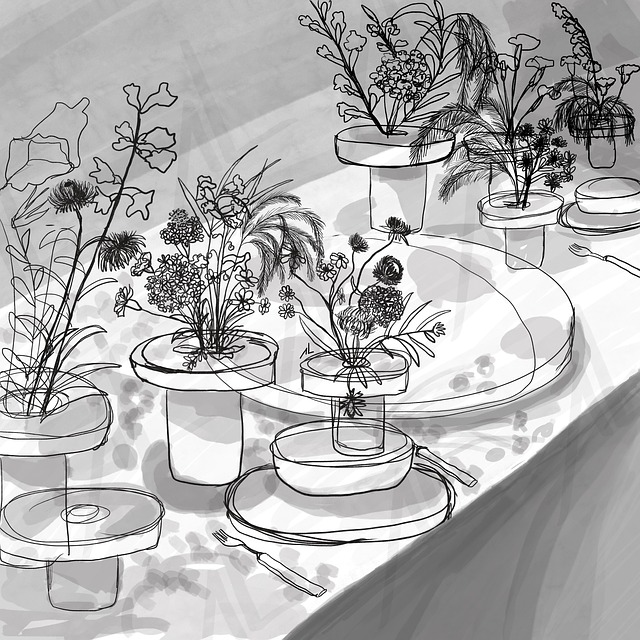Architectural CAD drafting is a powerful, digital tool that revolutionizes space planning by offering precise 2D and 3D visualization models. It enables architects to design, analyze, and optimize structures early in the process, saving time and resources. With dynamic manipulation capabilities, designers can explore various scenarios, adjust floor plans, reconfigure walls, and modify furniture arrangements easily. This precision and flexibility lead to better space utilization, enhanced aesthetics, and improved comfortability in every project, making architectural CAD drafting a game-changer for both designers and architects.
In today’s digital age, architectural CAD drafting is transforming space planning and layout optimization. This precise and powerful toolset empowers designers to create detailed, accurate models that enhance efficiency and functionality. By understanding the fundamentals of CAD drafting and its architectural applications, professionals can leverage advanced techniques for layout optimization, resulting in improved aesthetics, enhanced user experiences, and cost savings. Explore these innovations, from immersive AR/VR design to AI-driven automation, shaping the future of space planning with architectural CAD drafting.
The Role of Architectural CAD Drafting in Space Planning
Architectural CAD drafting plays a pivotal role in space planning, offering precise and detailed visualization tools that enable designers to transform concepts into tangible, functional spaces. By leveraging advanced software, architects can create accurate 2D and 3D models, allowing for thorough analysis of dimensions, proportions, and the overall layout. This process is instrumental in identifying potential issues early on, such as obstructed passageways or inefficient use of space, thereby saving time and resources during construction.
Moreover, architectural CAD drafting facilitates dynamic manipulation of designs, making it easy to explore different scenarios and alternatives. Designers can swiftly adjust floor plans, reconfigure walls, or modify furniture arrangements, all while maintaining a clear, visual understanding of the end result. This level of precision and flexibility is crucial for optimizing space, ensuring comfort and accessibility, and achieving the desired aesthetic appeal in any given project.
– Understanding the basics of CAD drafting and its architectural applications
Architectural CAD drafting is a powerful tool that allows designers and architects to translate their creative visions into precise, digital blueprints. It involves using computer-aided design software to create detailed 2D and 3D models of spaces, from residential homes to commercial buildings. In the realm of architecture, CAD has revolutionized how we approach space planning and layout optimization. By offering unparalleled accuracy and flexibility, it enables professionals to visualize, manipulate, and refine designs before construction even begins.
The applications of architectural CAD drafting are vast. It facilitates the creation of detailed floor plans, elevations, sections, and even virtual walkthroughs, providing a comprehensive understanding of a structure’s form and function. This technology ensures that every aspect of a building—from structural elements to furniture placement—can be precisely planned and adjusted, leading to more efficient use of space and improved overall design quality.
– How precise CAD models enhance space planning efficiency
Precise CAD models have transformed space planning and layout optimization, offering a level of efficiency and accuracy previously unattainable through manual methods. By leveraging architectural CAD drafting, designers can create detailed 3D representations of spaces, allowing for comprehensive visualization and analysis. This technology enables stakeholders to make informed decisions by identifying potential issues like misaligned walls or inadequate clearances before construction begins.
Furthermore, the precision inherent in CAD drafting ensures that space utilization is maximized. Designers can easily adjust dimensions, reconfigure layouts, and incorporate specific furniture or equipment requirements with exacting detail. This not only streamlines the planning process but also helps to avoid costly mistakes and delays during implementation, ensuring projects are completed on time and within budget.
Optimizing Layouts with Advanced Drafting Techniques
In the realm of space planning, architectural CAD drafting has evolved into a powerful tool for optimizing layout designs. Advanced drafting techniques enable designers and architects to create precise digital blueprints, ensuring every dimension and detail is accurately represented. This precision is paramount in maximizing space utilization, especially in compact areas where every inch counts. By leveraging these advanced methods, professionals can achieve streamlined floor plans that cater to contemporary lifestyle needs while minimizing waste.
The benefits extend beyond functionality; meticulous architectural CAD drafting also facilitates informed decision-making during the construction phase. Accurate drawings reduce errors and miscommunications, fostering a seamless workflow among stakeholders. Furthermore, these detailed blueprints seamlessly integrate with modern building information modeling (BIM) software, allowing for comprehensive project management and enhanced collaboration. This holistic approach to space planning not only optimizes current layouts but also paves the way for future modifications and expansions.
In conclusion, architectural CAD drafting plays a pivotal role in modern space planning and layout optimization. By leveraging precise models and advanced drafting techniques, professionals can streamline efficiency, enhance functionality, and achieve optimal designs. These tools empower architects to transform their creative visions into reality, ensuring every project is a testament to meticulous planning and innovative use of technology.
